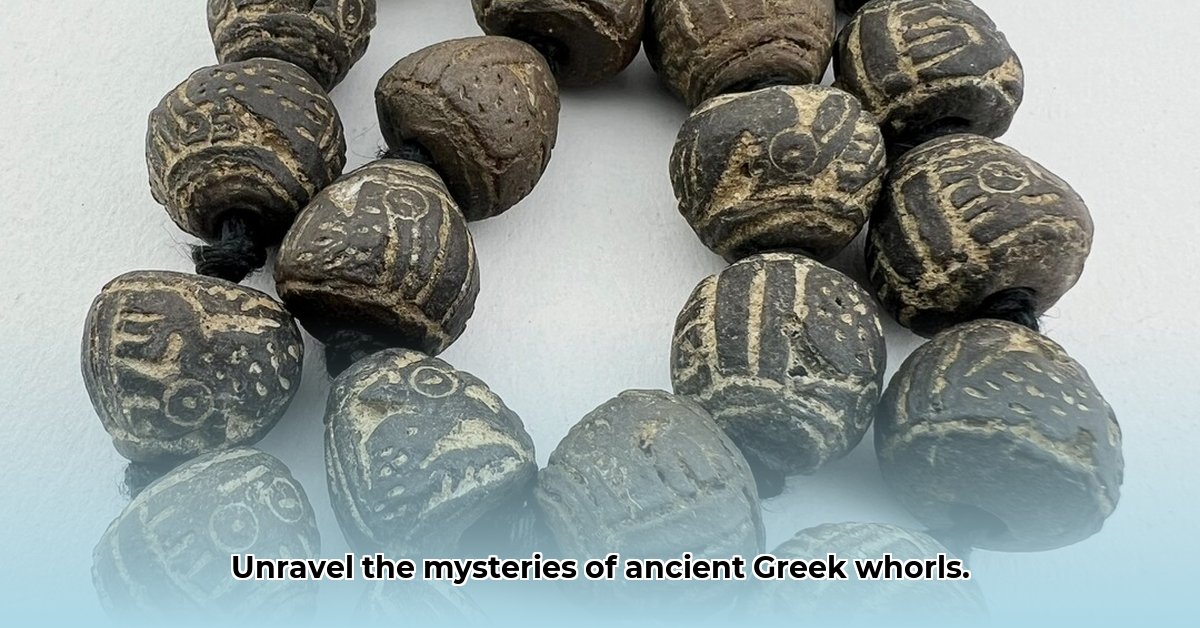Imagine unearthing the ruins of an ancient Greek home and discovering a small, unassuming clay disc. This isn’t just any artifact; it’s a spindle whorl – a humble tool that unlocks a wealth of information about ancient Greek society. More than mere spinning implements, these whorls were integral to daily life, reflecting the values and beliefs of the people who crafted and used them. This article invites you to explore the captivating world of ancient Greek spindle whorls, revealing how these seemingly simple objects offer profound insights into this remarkable civilization. We’ll examine their function, materials, aesthetics, and potential symbolic meanings, tracing the threads from spun yarn to the stories they tell about the lives of those who used them. For more on ancient Greek symbols, see [this helpful resource](https://www.lolaapp.com/ancient-greece-symbols/).
Delving into Ancient Greece: The Textile Industry Through Spindle Whorls
Envision ancient Greece, a time of thriving textile production. Picture bustling marketplaces, the rhythmic sounds of tools, and women diligently spinning yarn – the fundamental element of clothing and textiles. At the heart of this activity lay a small, unassuming disc: the spindle whorl. These weren’t merely simple tools; they represented technological advancements that shaped daily life, reflected social hierarchies, and hinted at deeply held religious beliefs. Let’s uncover the captivating narrative behind these ancient artifacts and explore the intricate world of textile production.
The Spindle Whorl: A Window into Everyday Life
Spindle whorls were indispensable for the production of yarn, the very foundation of clothing. Visualize them as ancient spinning weights. Attached to a spindle – a long, slender rod – the whorl provided essential weight, facilitating the twisting of fibers into yarn. This seemingly simple addition significantly accelerated the yarn-making process, enhancing the efficiency of clothing production. Archaeologists have unearthed thousands of these whorls throughout Greece, each serving as a miniature portal into the past, providing invaluable insights into ancient fiber arts. Their diverse shapes and sizes, crafted from a spectrum of materials, suggest a rich array of uses and social contexts.
Materials and Meaning: Exploring Ancient Craftsmanship
The materials employed in crafting these whorls reveal compelling narratives about ancient craftsmanship. Clay whorls were prevalent, likely due to the widespread availability and ease of shaping clay. These probably belonged to common folk. Stone whorls, often exhibiting more elaborate craftsmanship and enhanced durability, indicate a higher level of skill and potentially greater resources. The utilization of more precious materials such as bone, ivory, or even metal (particularly bronze) signifies luxury items, likely associated with wealthier households or perhaps reserved for special ceremonial purposes. While it’s tempting to assume heavier whorls equated to thicker yarn, spinning techniques also wielded considerable influence, rendering definitive conclusions challenging. Ongoing research continues to refine our understanding of this intricate relationship.
Symbolism Woven In: Decoding Spindle Whorl Designs
These whorls were far more than mere functional tools. Many showcase exquisite decorations featuring intricate designs – spirals, swirls, geometric patterns, and more. These weren’t arbitrary embellishments. Experts posit that these patterns possessed symbolic significance, potentially representing religious beliefs, social standing, or even personal preferences. Some scholars speculate that certain designs might have been associated with specific gods or goddesses, while others may have symbolized fertility, prosperity, or other key cultural concepts. These artistic choices offer a glimpse into the rich cultural lives of ancient Greek women. While definitively deciphering the precise meaning of every design remains elusive – they were, after all, created centuries ago – interpretations continue to evolve with ongoing research. How might future discoveries of new whorls reshape our understanding of their symbolic language?
Technological Advancements in Historical Context
The history of the spindle whorl also represents technological progress. Early spinning techniques were likely simpler, relying solely on manual twisting of fibers. The introduction of the whorl marked a significant leap forward, substantially enhancing spinning efficiency. While pinpointing precise dates for these advancements remains challenging, it’s evident that spinning techniques evolved over time. The archaeological record offers glimpses of this evolution, revealing changes in whorl design and likely corresponding adaptations in spinning processes. However, the fragmented nature of the evidence presents hurdles in establishing definitive timelines and regional variations.
A Snapshot: Types of Ancient Greek Spindle Whorls
The following table summarizes the characteristics of different types of spindle whorls found in ancient Greece. Note that these are broad generalizations, and variations exist:
| Material | Characteristics | Possible Significance |
|---|---|---|
| Clay | Abundant, easily shaped, simple designs, relatively inexpensive | Everyday use, common across all social classes, potentially reflecting local traditions and readily available resources. |
| Stone | Durable, often more finely crafted, varied designs, may exhibit greater artistry | Skilled artisans, potentially higher social standing, indicating access to specialized craftsmanship and durable materials. |
| Bone/Ivory | Rare, high-value materials, often intricate designs, showcasing skilled craftsmanship | Elite status, possible ritual or ceremonial connections, signifying wealth, status, and potentially a connection to symbolic practices. |
| Metal (Bronze) | Extremely rare, high status, ornate decorations, potentially reflecting wealth | Luxury item, possibly associated with wealthy elites, signifying immense wealth, power, and the ability to command rare resources. |
The Ongoing Quest: Resolving Mysteries
The study of ancient Greek spindle whorls remains an active field of inquiry. Archaeologists continually uncover new examples, contributing additional pieces to the puzzle. Advancements in technology enable detailed analysis of materials and manufacturing processes, revealing even more information that enriches our understanding. By comparing whorls discovered in Greece with those from other cultures, researchers aim to better comprehend the diffusion of spinning technology and its cultural implications. Each new discovery and analysis refines our current understanding, demonstrating how our knowledge of this seemingly simple object continues to evolve. Each whorl discovered contributes another layer to our understanding of life in ancient Greece.
How Ancient Spinning Techniques Shaped Spindle Whorl Design
Ancient Greek textile production relied heavily on spindle whorls. But how did spinning methods shape the whorls themselves? Let’s explore this connection and regional variations.
Spinning and Its Demands
Imagine a Greek woman spinning yarn. The rhythmic whir of the spindle, the steady pull of fibers—this was daily life. The spindle whorl, though small, was vital. Its weight, size, and material impacted yarn speed and consistency. Were heavier whorls always better? What about fiber types and textile processing?
Whorl Variations: A Spinning Reflection
Archaeological evidence shows many spindle whorls. They varied significantly in size, shape, and material. How did ancient spinning techniques influence spindle whorl design variations? This is key. The answer lies in the connection between desired yarn qualities and the tools used.
Fine yarns might have needed lighter whorls that spun faster, creating finer twists. Heavier whorls, perhaps stone or heavy clay, suited thicker yarns, needed for sturdy fabrics. Materials – clay, stone, bone, metal – also mattered. Clay allowed more decorations, while stone offered durability. This diversity reflects the range of textiles made in ancient Greece, from fine garments to robust household items.
Materials’ Implications
Whorl materials matter for spinning. Clay, readily available, allowed many designs and sizes. Stone, more durable, created heavier whorls, influencing spin speed and yarn thickness. Material choice likely reflected resource availability and yarn use.
Decoration as a Clue
Many whorls are decorated, adding complexity. These decorations weren’t just aesthetic; they might have indicated spinner skill, yarn use, or even symbolic meaning. Did a pattern signify a region or social status? Further research is needed, but these decorative elements are invaluable.
Beyond the Whorl: The Full Picture
Remember, the spindle whorl was part of spinning. Fiber preparation, fiber types (flax, wool, etc.), and spinner skill all impacted yarn quality. How did ancient spinning techniques influence spindle whorl design variations? It was a dynamic relationship, with the whorl adapting to spinners’ needs.
Key Points:
- Spindle whorl size, weight, and material directly influenced yarn properties.
- Whorl variations reflect diverse spinning techniques and textile types in ancient Greece.
- Decorative elements on whorls may indicate social status, regional styles, or symbolic meaning.
- Experimental archaeology can help us better understand ancient spinning techniques and whorl design.
Ancient Greek Spindle Whorl Decoration: Regional Styles and Social Significance
Spinning yarn was fundamental to ancient Greek life. Imagine the hours spent creating textiles that clothed, adorned, and defined their world. At the heart of this process lay the humble spindle whorl – a decorated disc, crucial for spinning thread. But these weren’t just simple tools. They were miniature works of art, reflecting the Ancient Greek Spindle Whorl Decoration: Regional Variations and Social Significance.
The Everyday Tool and its Evolution
Spindle whorls, weights attached to spindles, varied greatly across regions and time periods in ancient Greece. Early examples were simple and functional, often made from readily available materials like clay or stone. However, as technology and artistry developed, so did the whorls. Think of them as tiny time capsules, each reflecting its creator’s skills and community’s aesthetics. Their designs evolved, mirroring broader artistic trends across the Archaic, Classical, and Hellenistic periods used for textile art.
Materials and Morphology
The materials used reveal much about the region and its resources, making the whorls ancient art. Some whorls, especially in areas with abundant clay, are made from terracotta, often adorned with intricate patterns. Others utilize bone, stone (like marble or limestone), or even metal—revealing variations in wealth and technology. Their shapes were also diverse, ranging from simple discs to more complex forms, some even resembling animals or mythological creatures.
Decoding the Decorations: Art and Symbolism
The decorative elements on these small objects tell stories about symbols and signs. Geometric patterns, swirling spirals, and representations of plants and animals are commonly found and used as fiber art. Were these designs purely aesthetic, or did they hold deeper meaning? Many scholars suggest that patterns might indicate a spinner’s skill, social status, or even religious affiliations. Could a certain motif have indicated membership in a specific cult or family? These questions fuel ongoing research.
Regional Styles and Their Significance
Ancient Greek Spindle Whorl Decoration: Regional Variations and Social Significance is evident in regional stylistic variations. Whorls found in Athens might differ significantly from those unearthed in Corinth or Sparta. These differences aren’t merely aesthetic; they suggest distinct cultural identities and give insight into textile art culture. Imagine the marketplace, with spinners from different regions showcasing their unique whorls, each a testament to their local traditions and artistic styles.
The Spindle Whorl’s Place in Society
These small artifacts weren’t just tools; they were part of a larger societal fabric. The act of spinning was usually associated with women, a significant part of both domestic and economic life. Their presence in burials suggests that these tools held symbolic importance, perhaps representing the skills and contributions of the deceased to their community. Were they viewed as a reflection of a woman’s life work, passed on to the afterlife?
Threads and Tales
The study of ancient Greek spindle whorls offers a unique lens through which to view the past and give insight into textile history. They provide insight into ancient technologies, artistic sensibilities, and societal structures. They represent not just craft tools, but embodiments of cultural identity, skill, and perhaps even spiritual beliefs. Each small whorl whispers a story of ancient lives, and their meticulous study continues to unveil the rich tapestry of ancient Greek civilization.
Key Pointers:
- Ancient Greek spindle whorls were integral to textile production.
- Whorl materials and shapes varied widely, reflecting regional resources and technological advancements.
- Decorative motifs likely held symbolic meaning, relating to social status, religious beliefs, or personal identity.
- Regional variations in whorl designs indicate distinct cultural identities.
- Spindle whorls held social significance, extending beyond their practical function.
The Role of Spindle Whorls in Ancient Greek Textile Production
Key Conclusions:
- Ubiquitous Female Role: Textile production, focusing on spinning and weaving, was mainly a female job in ancient Greece.
- Consistent Techniques: Basic spinning and weaving methods remained consistent across centuries, using drop spindles and warp-weighted looms.
- Social and Economic Importance: Textiles were crucial to the Greek economy and held deep cultural and religious importance.
- Spindle Whorl Variety: The design, material, and decoration of spindle whorls varied, potentially reflecting social status and regional differences.
- Limited Evidence: Our understanding is incomplete due to limited surviving textile fragments and a bias in textual sources.
- Ongoing Research: Further research, including interdisciplinary approaches, is crucial to improve our grasp of this vital aspect of ancient Greek life.
Decoding the Ancient Greek Spindle Whorl
Picture a tiny disc of clay, stone, or bone. This object—a spindle whorl—holds a key to understanding ancient Greek women’s lives. These small weights, attached to spindles, were essential to the ancient textile industry. The role of spindle whorls in ancient Greek textile workshops and domestic production was more significant than their size suggests. They were integral to the clothing, tapestries, and textiles that shaped daily life.
Textile Production: A Woman’s World?
Ancient Greek literature and artwork show women spinning and weaving. However, was it exclusively female? While the main narrative points to women, some references and finds hint at male involvement, particularly in larger workshops or those using enslaved labor. The ambiguity underlines a limitation: a lack of firsthand accounts from women themselves.
Spinning Mechanics
The process was simple yet demanding. A fiber, like flax or wool, was attached to a spindle—a rod with a whorl at the bottom. The whorl, acting as a weight, gave the spindle stability as it spun, twisting the fiber into yarn. This yarn then formed the basis for weaving on a loom. The whorl’s design and material reflected the spinner’s skills and social standing.
Whorl Variations: Society’s Glimpse
Archaeological discoveries reveal many spindle whorls. They differed in materials (clay, stone, metal, bone), size, shape, and decoration. Some were plain, while others were intricately decorated, suggesting varying craftsmanship levels and social status. The decorative elements sometimes hint at religious or symbolic meanings, making this ancient textile tool interesting for textile art lovers. Were elaborate whorls status symbols, or did they hold cultural significance?
Connecting Threads: Symbolism and Religion
The association of goddesses, like Athena, with weaving highlights textiles’ cultural significance. In mythology, the Fates—the Moirai—spun, measured, and cut the thread of life, emphasizing spinning and weaving’s symbolic importance. Could some spindle whorl decorations reflect these images, or local beliefs and traditions? These are open questions that tantalize researchers today.
Challenges and Future Research
While evidence exists, our understanding is incomplete. The fragility of textiles means few have survived. Many questions linger. What regional variations existed in spinning techniques? How did textile quality and types vary by social class? Further research, combining archaeological finds with literary accounts and advanced analytical methods, is needed to fully unravel ancient Greek textile production and the role of spindle whorls in ancient Greek textile workshops and domestic production.
- Unlock Ancient Greece: Vase Painting’s Hidden Stories - August 12, 2025
- Beyond Myths: Interesting Facts Ancient Greece Reveals Lasting Civilization Legacy [Reference] Actionable Insights - August 12, 2025
- Unveiling hair in ancient Greece: Secrets of styles, rituals, and meanings revealed - August 12, 2025















